
Britain in the early history of the James Webb Space Telescopeby Harley Thronson
|
| An early engineering solution to the twin constraints of small aperture and abbreviated lifetime, which eventually would make possible NASA’s James Webb Space Telescope (JWST), would be contributed by an unlikely source. |
A trio of increasingly powerful, successful infrared space observatories were developed or operated during this period. The entire IR sky was surveyed by the Infrared Astronomical Satellite (IRAS) a joint mission of the United States, the United Kingdom, and the Netherlands launched in early 1983. About a decade later in late 1995, the European Space Agency (ESA), in cooperation with NASA and the Japanese agency, now part of the Japanese Exploration Agency (JAXA), launched the Infrared Space Observatory (ISO). And throughout this period, NASA proceeded on the last of the Great Observatories, the Space Infrared Telescope Facility (SIRTF), later renamed the Spitzer Space Telescope), which launched in 2003. NASA’s Cosmic Background Explorer (COBE), launched in 1989, provided unrivaled information about the origin and early years of the Universe, producing a pair of Nobel Laureates. Through these missions, scientists and engineers were learning critically important lessons about designing and building extremely cold spacecraft optics and detectors.
Including ground-based, balloon, and airborne infrared telescopes, there was little surprise that in the US, the 1991 National Academies’ Decadal Survey, The Decade of Discovery, dubbed the 1990s as “The Decade of the Infrared.” Enthusiasm for infrared observations from space was growing rapidly.
However, and not universally appreciated at the time, the ultimate scientific performance of this first generation of IR space observatories was seriously limited by the very design that made them successful.
Space observatories designed to operate sensitively at IR wavelengths require extremely low temperatures for the detector/instrument system and to reduce the contaminating emission from the telescope optics. IRAS, ISO, and SIRTF adopted the same engineering solution: use tanks of liquid cryogens—that is, liquid helium—for these missions. This solution was demonstrably successful, although with an intrinsic limitation that the missions’ telescope aperture was constrained largely by the cryogen tanks: 57, 60, and 85 centimeters, respectively, for the three missions. Furthermore, because the optical system was cooled by liquid helium boil-off, mission lifetimes were unavoidably limited.
An early engineering solution to the twin constraints of small aperture and abbreviated lifetime, which eventually would make possible NASA’s James Webb Space Telescope (JWST), would be contributed by an unlikely source.
This is that story.
“There’s a way to do it better. Find it!”
— Attributed to Thomas Edison
There are a handful of relatively short histories of the early precursors to the James Webb Space Telescope (JWST), most of which concentrate on, or are limited to, activities in the US. My article will, instead, describe significant early activities outside the US, primarily in Britain, some of which have been also discussed in Davies [1], Smith [2], Stockman, ed. [3], Mather and Boslough [4], and Rowan-Robinson [5].
In the 1980s, Dr. Timothy Hawarden (Figure 1), a staff scientist at the Royal Observatory Edinburgh (ROE), was an instrument co-investigator on ISO. As he described later in his words, the ISO cryogenic system was “horrendously complicated” and would limit the telescope’s aperture and lifetime. Consequently, in the mid-1980s, he began to calculate how cold a space observatory could be using only radiative cooling. Working largely on his own, using his hand calculator, he laboriously explored the limits to radiative cooling of different mission designs. Hawarden eventually concluded that some plausible designs that included multiple radiation shields would equilibrate at a few tens of kelvins at the primary mirror. This could be accomplished without the inexorable limitations to science of small aperture and short lifetime imposed by using massive tanks of liquid cryogens.
For example, an optical system at about 40 kelvin would enable sensitive operations in space at wavelengths as long as roughly 30 microns. Even lower temperatures would be possible using additional—for example, closed-cycle mechanical—cooling systems. Although other radiatively cooled space telescope designs were being produced at that time, no reported mission concept using radiative cooling alone reported a temperature as low as Hawarden’s. [These newer, primarily radiatively cooled concepts will be referred to here as “second-generation.”]
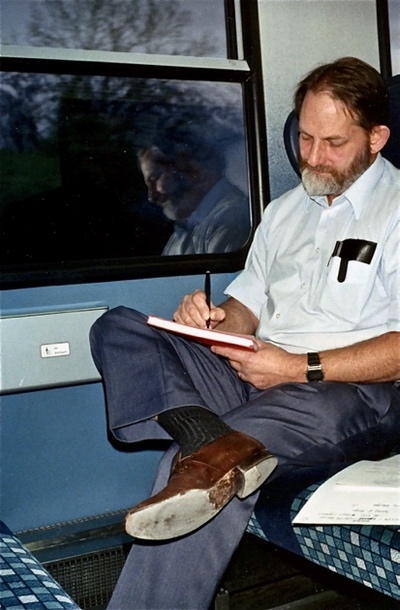 Figure 1 – Dr. Timothy Hawarden in about 1990 aboard one of many trains in Europe traveling to give presentations on the effectiveness of radiative cooling to enable our designs for second-generation infrared space telescopes. [Photo by the author.] |
Hawarden concluded that his initial modeling was sufficient to justify more sophisticated analysis. In 1989, he persuaded the ROE administration that his mission concept, the Passively cooled IR Observatory Telescope (POIROT), should be considered for a proposal in response to ESA’s Second Medium Mission (M2) solicitation. Dr. Malcolm Longair, ROE director and Astronomer Royal of Scotland, was impressed with Hawarden’s hand-calculator results, although wary about submitting an unexamined concept so profoundly different from conventional designs for IR space observatories. He therefore convened ROE engineering and scientific staff in Edinburgh to critique POIROT intensely over a long weekend. Hawarden’s calculations were confirmed, and a 1.5-meter POIROT concept was submitted for ESA funding by ROE.
Hawarden’s design effectively incorporated multiple large radiation shields (Figure 2), whereas other published designs at the time had fewer shields or none at all. Multiple shields were calculated to be essential (Figure 3) and would be incorporated in all subsequent designs produced in the UK and, eventually, JWST.
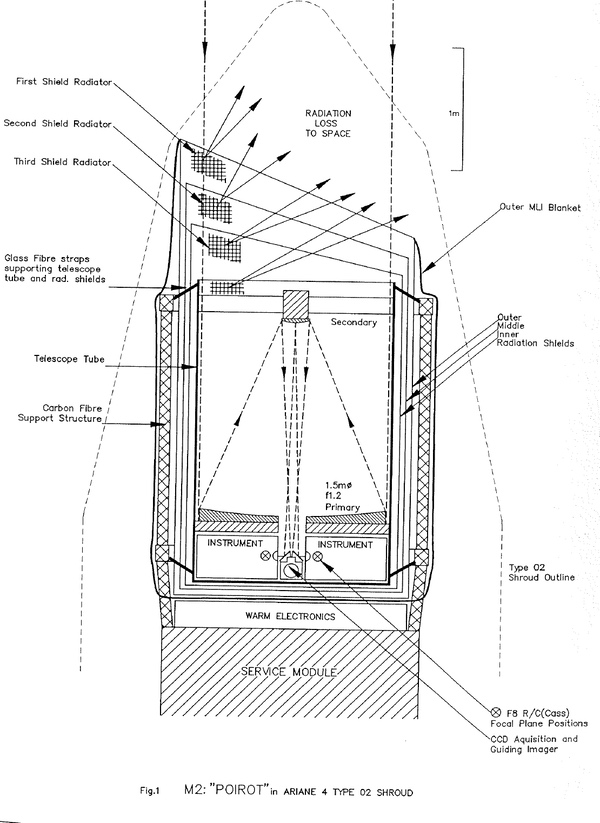 Figure 2 – Schematic design in the 1989 POIROT 1.5-meter proposal from ROE to ESA showing the multiple radiation shields necessary to achieve the very low system temperatures required for sensitive IR observations in space. JWST would later also adopt multiple radiation shields. |
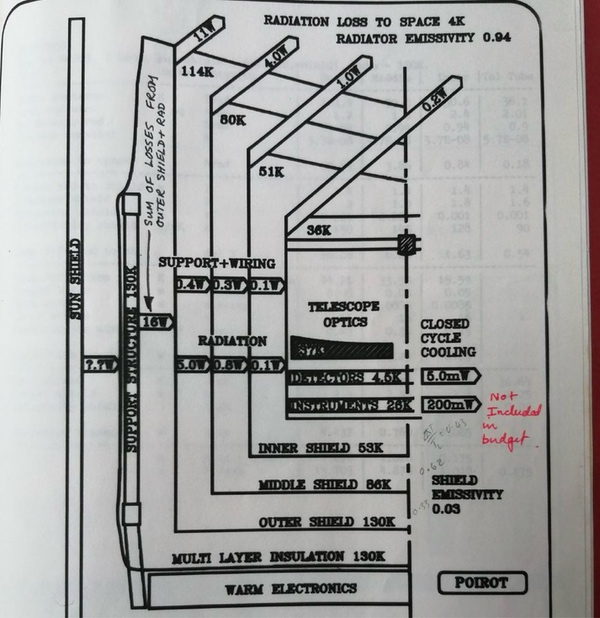 Figure 3 – The diagram of the POIROT thermal model from that concept’s 1989 ESA M2 proposal from ROE. The thermal effects of the necessary multiple radiation shields and adopted conduction within the system, and the resulting temperatures, are shown. [Handwritten notes in the original.] |
In 1990, ESA declined to select POIROT for funding of further design work, although recognized its importance. Many years later, Tim Hawarden received posthumously the NASA Exceptional Technology Achievement Medal for his POIROT concept, with the citation noting “the breakthrough concepts that made possible the James Webb Space Telescope and its successors.”
The Edinburgh-based POIROT team at the time was by no means alone in assessing application of radiative cooling. At the influential 1989 Next Generation Space Telescope workshop [6] hosted by the Space Telescope Science Institute (STScI), a future large-aperture UV-visual-IR space telescope was discussed extensively. At that workshop, Tulkoff [7] presented a handful of relatively basic optical designs calculated to reach about 70 K for optimum orientations. (At that conference, “sage advice” suggested, however, that the lower limit to radiatively cooled space optics was 100 K, a temperature that was cited occasionally to the POIROT team while developing their 40 K concept.)
| Teams both in the US and UK were actively pursuing how to achieve three significant design characteristics of all IR space telescopes: very low temperatures, long operational lives, and large apertures. |
Different orientations were less successful in achieving very low temperatures, as solar radiation falling directly on the observatory was unimpeded. Another relevant mission, NASA’s COBE, [4] was able to reach about 50 K by also taking advantage of radiative cooling. In Europe, the ISO Pre-Phase A design in late 1980 for ESA described a design with most of the optics at ambient temperature before launch, optics that would later to cool via radiation to a very low operating temperature. Liquid helium would be used to cool the instrument system. (See the next section for a brief description of Phase A mission design.) About a decade and a half later, NASA’s Spitzer incorporated a similar design for its successful “warm launch” mission. (The author, after some effort, was not able to determine why the ISO team did not adopt the Pre-Phase A design.) In addition to the very low optical system temperatures required for sensitive IR observations, optical systems with apertures far larger than possible in the first generation of IR space observatories were being assessed during the same period by, for example, Bely et al. [8]
That is, teams both in the US and UK were actively pursuing how to achieve three significant design characteristics of all IR space telescopes: very low temperatures, long operational lives, and large apertures. The next stage was to successfully integrate the three into a single design.
“Everything comes to him who hustles while he waits.”
--- Attributed to Thomas Edison
The European Space Agency declined in 1990 to fund further design work on the ROE POIROT concept. The ESA review teams recognized in Hawarden’s concept an attractive, even breakthrough, capability for an important future space observatory. The POIROT proposal itself was deemed too sketchy to justify selection as a new mission. However, the POIROT team was encouraged to further develop the concept.
Rather than retire for a few years, waiting for the next ESA call for proposals, the small POIROT team considered opportunities across the Atlantic: that is, NASA, and the US National Academy’s 1991 Decadal Survey or, colloquially, The Bahcall Committee [9], especially with its encouraging declaration of the 1990s as “The Decade of the Infrared.” Although events would eventually teach sobering lessons, the optimistic POIROT team concluded that it was reasonable that there would be enthusiastic recognition of a new and enabling engineering capability. Presumably, the other contemporaneous IR space mission concept activities concluded similarly.
It was not to be. The Survey itself and its “Infrared Astronomy” working paper were ambiguous about IR space missions and relevant technologies for major post-Spitzer IR space observatories, other than the “first-generation” engineering solution that required tanks of liquid cryogens, along with the doomed Large Deployable Reflector concept. (LDR studies perhaps never recovered from when it was memorably referred to in a seminar on the mission as the “Large Deplorable Reflector.”) The major exception in the Survey, ironically, was in the “UV-Optical from Space” working paper (Illingworth and Savage, ed. [10]), which outlined the design and scientific capabilities of a six-meter visible-IR space telescope with optics radiatively cooled to 150 K.
(A recommendation for a future large-aperture, radiatively cooled IR space telescope did not appear in the Decadal Survey itself. About the time of the publication of the Survey, the preliminary Edison design with optics cooled radiatively to about 50 K had been presented at the conference in Edinburgh on next-generation IR space observatories [11] and at IAU Colloquium #123 in Greenbelt [12].)
| Our architecture was intended to be a “proof of concept.” That is, despite limited resources, we had to produce a plausible initial engineering design for an operational second-generation IR space observatory. |
Although with the surpassing success of JWST, it is difficult to appreciate today that only three decades earlier, there was no substantive recognition by NASA, ESA, or some professionals of the value of exploring designs for IR space observatories enabled by radiative and closed-cycle cooling. The small, mainly British, POIROT team was committed to the value of that concept, and concluded that subsequent designs, to be persuasive, would have to be far more complete, detailed, and, therefore, credible, if only as a so-called “proof of concept.” But, with limited financial support, colleagues able to allocate some of their professional efforts would have to be sought.
I had limited participation in the POIROT proposal, although participated in the review of the ESA decisions. It was at this point, in 1990, that I agreed to coordinate the team’s subsequent efforts. Thus, was born Edison, named after the noted American inventor and who, in the late 1870s, was experimenting in Wyoming Territory, near where I was employed at the time, with a highly sensitive IR detector for astronomical observations. I recommended the name, at least in part, to attract positive American attention.
Unfortunately, despite interest in the US on second-generation IR space observatory designs, much of the American scientific leadership seemed indifferent to relevant activities in Britain. Fortunately, there was talent to be engaged in the UK, specifically at Rutherford Appleton Laboratory (RAL), near Oxford. By good fortune and the timely involvement of Dr. Alan J. Penny, the RAL administration in late 1991 recognized in POIROT the basics of an Edison proposal in response to an expected ESA solicitation, a proposal which would require relatively modest resources to prepare. RAL generously allowed several of its space engineers to take time away from their assigned duties to contribute to the Edison architecture.
We had little time—no more than three years—before our next submission to ESA (i.e., M3). We also recognized that our professional colleagues, working part time, had limited, although very much appreciated, availability. We had no choice, therefore, but to identify the handful of key observatory systems and characteristics necessary to produce a credible proof of concept. There were several alternative spacecraft systems, unfortunately, for which there was insufficient time to be properly evaluated.
Space radiative cooling designs were being assessed in multiple locations at the time. Telescope optical design and structures were, likewise, being investigated, notably in the US: essential work, as it would turn out. However, our Edison proposal to ESA was going to require a sufficiently persuasive design that incorporated numerous additional observatory systems in addition to radiative cooling. That is, not only a detailed thermal model derived from Hawarden’s POIROT original concept, but, in addition, a detailed optical design (in our case, kindly contributed by Eastman Kodak); system and subsystem operation, along with total mass; instrument complement; communications and onboard data-handling systems; a plausible launch vehicle and operational orbit; a basic science program; initial rough cost estimates; and notional development schedule. All that, if credible, would approximate an ESA Phase A architecture, which we would use to engage the astronomy and space engineering communities.
Our architecture was intended to be a “proof of concept.” That is, despite limited resources, we had to produce a plausible initial engineering design for an operational second-generation IR space observatory. Engineering evolution would continue after our initial efforts concluded.
To be responsive to ESA’s M3 solicitation, the team’s architecture had realistically to fit within constraints of cost and available launch vehicle. That is, we designed Edison, with an aperture of 1.7 meters—about four times the collecting area of NASA’s final Great Observatory, Spitzer—to be the largest-aperture IR observatory architecture allowed by the ESA M3 solicitation. The cost limit for an ESA M3 mission at the time of our proposal was about $200 million (1989 dollars). This is about twice the cost estimate in our Edison proposal. Thus, several cost-saving and -sharing options were identified. However, at this very early stage of our architecture, any cost estimate is far too premature to be believable.
As it happened, about three years after our Edison architecture was completed, NASA Administrator Dan Goldin directed the American agency to consider apertures much larger than ours (see Epilogue.) As noted above, teams at about that time in the US had developed designs for large-aperture space telescope designs, notably by adoption of “open” optics designs, not constrained by the telescope tube as Edison was. See Bely et al. [13] for a recent history of JWST, which discusses options considered for that mission’s optical designs.
Our RAL “proof of concept,” a large-aperture, radiatively cooled IR space observatory operating at the Sun-Earth L2 halo orbit, was submitted to ESA in May 1993. (See our artist’s 1992 conception that opens this article.) Subsequent large-aperture architectures, which responded to NASA Administrator Goldin’s 1996 challenge to design a very large-aperture IR space observatory, were published in 1997, when the studies funded by NASA and coordinated by Goddard Space Flight Center were reported by Stockman, ed. [3].
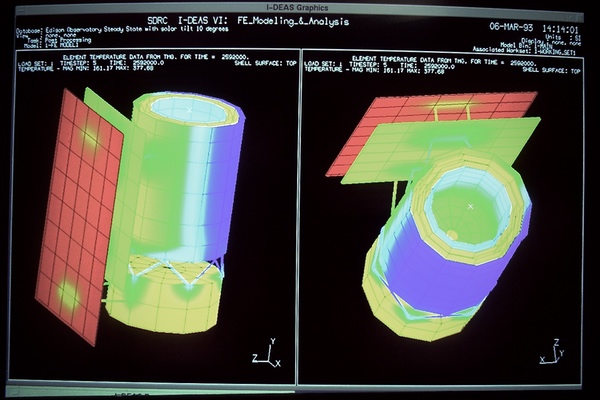 Figure 4--Three-dimensional thermal models of Edison were used in early 1993 to explore use of multiple radiation shields when the observatory was in operation in its halo orbit around the Sun-Earth L2 point. In this display, red is hotter, blue is colder. These models were produced by University of Wyoming engineering graduate student Robert Crane, to support the Edison M3 proposal to ESA. Crane was able to take time off from his Master’s thesis on snowplow design to produce this series of thermal models under the direction of the author. Longer accounts of Crane’s contribution to the thermal design of Edison can be found in the February 14, 1994, issue of the Laramie Daily Boomerang and [22] |
Since successful IR space missions before that time had relied on large tanks of cryogenic liquid, critical for the Edison architecture—and central to advocating among colleagues—was a detailed thermal model for radiatively cooling (see, e.g., Figure 4). A relatively warm portion of the spacecraft encroaching on the path of the observatory’s optical system, for example, would severely limit system sensitivity. Our thermal model was used to assess, in improved detail, the effects of the multiple radiation shields adopted originally by POIROT, including their optimum number, coatings, configuration, and how changes in the orientation of the telescope altered the temperature distribution. The final RAL Edison design ( [14], [15], and [16]) showed that the temperature distribution as the observatory pointed toward multiple directions could be managed, in part, via a large multi-layer sunshade.
In all designs for IR space observatories, the choice of operational location is critical. Our very tight schedule to prepare for the ESA M3 opportunity did not allow significant trade studies among possible orbits, although by that time it was clear that greater distance from the Earth than IRAS or ISO was essential to achieve low system temperatures [13]. Our team was persuaded by the work of Farrow [17], which was based on the seminal work of Farquhar and Dunham [18], that a halo orbit around the Sun-Earth L2 location had very attractive characteristics for our purposes: for example, this semi-stable orbit far enough away from heating by the Earth, also allowed the multi-layer radiation shield to be relatively easily oriented to effectively block the sunlight. The JWST design team would come to the same conclusion.
| Our widely circulated architecture began to attract some very pointed criticism originating in the US, apparently by advocates of telescope cooling by large tanks of liquid cryogens. |
As the Edison architecture continued to show promise, thanks to RAL personnel and other collaborators, our team recognized that the results would have to be widely assessed by colleagues skeptical of an engineering design so fundamentally different from the successful first-generation IR space observatory designs. There were too few resources available for our team to travel extensively, for example, from the UK to various sites in the US to discuss the evolving Edison architecture. Even more challenging, we understood that there would be only three years, probably less, between the ESA M2 solicitation in 1989, to which we responded with the POIROT concept, and the subsequent M3 solicitation to which we would respond with Edison. That is, an inexorable clock was ticking.
Consequently, as our engineering design work progressed, our team adopted an affordable, focused, three-component strategy to achieve our goal of wide community support: (1) prompt publication, beginning in 1990, of results of our RAL Edison design work, including copies of our architecture [14] posted to several dozen individuals and institutions in the US and Europe; (2) relevant annual professional conferences in Europe; and (3), as time permitted, colloquia throughout Europe. See images in Figures 1, 5, 6, and 7 as a few examples from our series of conferences.
Astronomers and spacecraft engineers from Europe, the US, and Japan attended the conferences, discussing proposed future missions, including Edison. The conference proceedings were often published in special editions of professional journals. In addition, the Edison team published, through about 1995, a half-dozen articles about the architecture and scientific capabilities. In addition to our widely circulated architecture itself [14] see, for example, [12], [15], [16], [19], [20], and [21].
The first conference specifically on Edison, and including other IR space observatories, was held in Edinburgh during May 1991 (proceedings in Bell Burnell, Davies, & Stobie [11], see also our first publication specifically about Edison in 1990 [12].) Presentations in Edinburgh (Figures 5 and 6) included a lengthy tutorial on designing radiatively cooled observatories and an initial design for Edison. Subsequent workshops were held in Paris and Berlin (e.g., Figure 7).
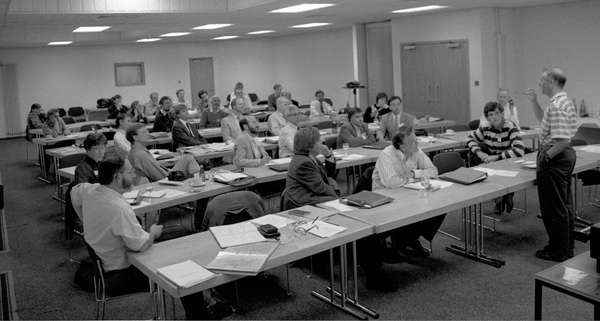 Figure 5 – Royal Observatory Edinburgh (ROE) director, Dr. Malcolm Longair in May 1991 summarizes priority science goals for a large-aperture IR space observatory and the status at the time of the Edison architecture. [Courtesy ROE] |
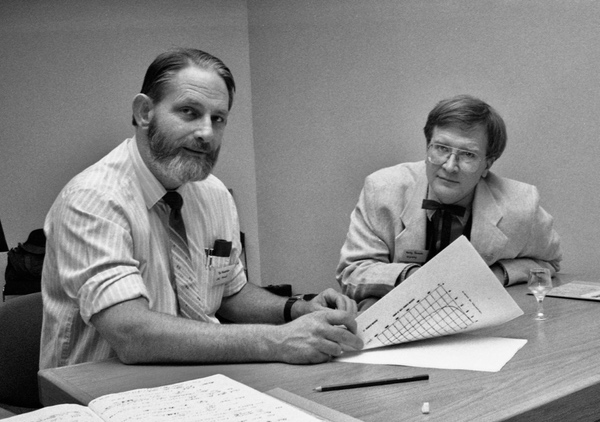 Figure 6 – Preparing the presentation of an initial design for Edison and our first (of many) tutorials on radiative cooling in space, Dr. Timothy Hawarden (left) and the author in Edinburgh at the May 1991 workshop on future IR space observatories [11]. [Courtesy ROE and the author] |
As our Edison design became more fully developed, at NASA Headquarters, Dr. Larry Caroff, the senior IR scientist, was giving serious consideration on how to coordinate it with the US SIRTF mission to the benefit of both. However, as Rottner notes in her management history of SIRTF [22], some senior US scientists were incredulous that the small, few-year-old Edison design, led by ROE and University of Wyoming—of all places!—could become the basis of a mission superior in performance to SIRTF, which had been studied for two decades.
Consequently, our widely circulated architecture began to attract some very pointed criticism originating in the US, apparently by advocates of telescope cooling by large tanks of liquid cryogens. Our team never determine, or was sent, the engineering design(s) that supported the criticism of radiative cooling.
One memorable critique purporting to assess the feasibility of radiative/mechanical cooling in space, for example, calculated that it would take years for designs broadly similar to Edison (e.g., JWST) to radiate enough heat to reach operating temperatures of a few tens of kelvins. Our speculation was that the American engineers who produced the criticisms had misapplied the radiation laws and/or miscalculated conduction within the system, or made simple computational errors.
Attention was paid to this criticism, as, of course, reaching a very low operating temperature in a reasonable length of time was a paramount issue in any radiative/mechanical cooling architecture. We assumed that such a debilitating criticism had been carefully vetted at its origin, although apparently not. The Edison team responded to the critique with a basic tutorial on how radiation and conduction work in space. Several strained weeks passed, but nothing ever again was heard from these critics.
Our relatively small design activity, thus, survived, apparently having taken a bullet on behalf of subsequent second-generation designs. That ill-advised attempt apparently to derail our architecture study has been commented on elsewhere ( [1], [4], [22]) and was the first critique of a large-aperture radiatively cooled IR space telescope, but by no means would be the last.
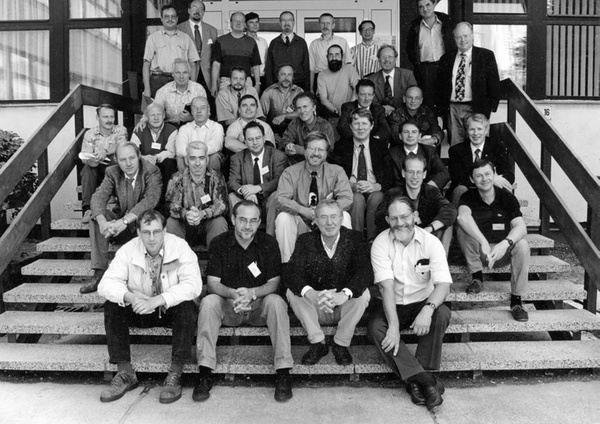 Figure 7 – Group photograph of participants at the September 1995 Berlin conference on future IR space observatories. The author, smiling, is near the middle of the image. Dr. Tim Hawarden is in the lower right. [Image courtesy the author] |
The Edison proposal and architecture, endorsed by about 85 scientists and engineers in Europe and the US, was submitted in response to the third ESA Medium Mission (M3) solicitation in early 1993 [14].
An illustration of our effort to initiate a new mission, products of our strategy over about five years—publications, proposals, conferences—to design and advocate for a future large-aperture IR space observatory is displayed in Figure 8. (Readers interested in the complex, challenging, but ultimately successful, process to initiate major new NASA science programs are encouraged, for example, to read Smith [27] on HST and Rieke [28] and Rottner [22] on SIRTF.) Over about three years, and thanks to the efforts contributed largely by colleagues at RAL and ROE, we produced six refereed publications, two funding proposals to ESA, and three international professional conferences initiated and/or organized by the Edison team and interested colleagues. This figure does not include an estimated two dozen professional seminars in Europe and the US.
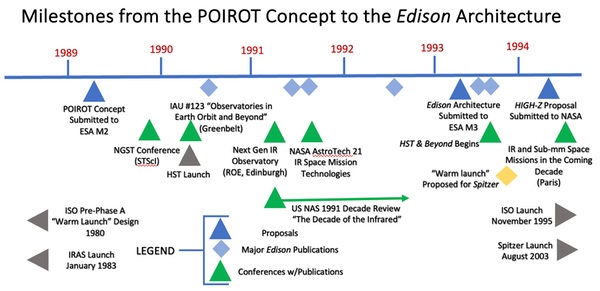 Figure 8 – Relevant conferences, workshops, publications, and science mission launches that took place during the period covered by this article. Some of the symbols and text have been shifted slightly for clarity. The publication symbols have been placed in the center of a year due to the difference in times among manuscript submission, acceptance, and publication. In chronological order, from left to right, the six Edison publications (light blue diamonds) are [12], [19], [23], [24], [20], and [16]. |
Unfortunately, ESA declined to select Edison for further engineering design work in favor of more thoroughly developed mission designs, although the agency pointedly recognized the value of our architecture in its evaluation:
“Edison is a logical follow-up to ISO [and] enables a wide suite of astrophysical observations embracing important issues, ranging from planetary science to cosmology. [Passive and mechanical cooling] are appealing and represent a logical path for cooled telescopes of the future.”
ESA's Astrophysics Working Group, with ESA Space Science Advisory Committee in concurrence (1993)
By focusing on only the most essential systems of a plausible IR space observatory to produce the Edison proof of concept, our severely resource-limited advocacy strategy was successful in attracting the attention of other colleagues. Over subsequent years, numerous assessments and histories cited Edison as being notably influential (e.g., Dressler et al. [25], Smith [2], and footnote 24 in Rottner’s management history of SIRTF [22]).
A noteworthy observation was in the report on the results of the three NASA-funded early designs for the Next Generation Space Telescope (NGST; later renamed JWST) in Stockman, ed. [3]:
[Chapter 2] describes the advantages and requirements of an NGST. The NGST study has been greatly influenced by many other concepts of passively cooled telescopes, in particular the Passively Cooled Orbiting Infrared Observatory Telescope (POIROT) and the Edison Infrared Space Observatory and the Mid-Infrared Optimized Resolution Spacecraft (MIRORS).
By 1995, our primarily UK activity, mainly part-time using effort taken away from regular duties, had reached its limit available to support Edison architecture studies. Substantial subsequent work would require full-time paid professionals, which seemed unlikely. The last publication by the Edison team was a 1995 assessment of space, airborne, and ground-based observatory sensitivities as a function of, mainly, telescope aperture and primary mirror temperatures [21].
| In retrospect, with significant mission design work undertaken already in both the US and the UK, what would eventually become the James Webb Space Telescope had become inevitable. |
Our Edison architecture included a notional science program. The team remained committed to the very significant and exciting capabilities of large apertures and long mission lifetimes for IR space observatories, which years later would be realized by JWST. However, after a five-year effort, neither POIROT nor Edison was funded for study.
Similarly in the US, NASA and the 1991 National Academies’ Decadal Survey (aka, “The Decade of the Infrared”) showed little enabling interest in a future large-aperture, radiatively and mechanically cooled IR space observatory. The fourth Great Observatory, Spitzer, was consuming a great deal of human and financial resources. In late 1993, it adopted radiative cooling, at least partially, to make it affordable and, hence, feasible. Spitzer was launched on its successful mission in the summer of 2003.
As the Edison effort approached its close in 1995, some members of its team ruefully noted that Edmond Burke’s famous dictum was painfully prescient:
Those who carry on great public [plans] must be proof against the worst delays, the most mortifying disappointment, the most shocking insult, and what is worst of all, the presumptuous judgement of the ignorant upon their design.
Fortunately for JWST, although work on a future IR space observatory wound down in the UK, teams in the US had been evaluating designs for large-aperture IR space observatories that applied radiative cooling. I noted above the high visibility given a major future visual/infrared space observatory at the 1989 workshop at the Space Telescope Science Institute (STScI) [6]. The introduction in that workshop report emphasized the criticality of investing in technologies and design work on missions even before a precursor is launched.
Furthermore, among other US activities, STScI in 1994 proposed the High-Z (Stockman et al. [26]) mission to NASA, which the agency declined to fund, marking the third formal proposal for a major IR space observatory for which funding was sought from a major space agency. (A prominent European astronomer commented several years later that exploring radiative cooling for IR space observatories probably led to “the most successful mission designs that never flew.”)
Finally, however, there was a breakthrough in thinking about the US long-range strategy for space astronomy. The Association of Universities for Research in Astronomy (AURA), funded by NASA, chartered a team that began in 1994 to consider in depth what might follow the Hubble Space Telescope. The “Dressler Committee” report, HST and Beyond, [25] in 1996 proposed “the search for origins” as a motivating goal for space astronomy. (For this work the Committee received the 2017 Carl Sagan Memorial Award from the American Astronautical Society.) This goal would be achievable by continuing to operate HST—by no means a certainty at the time—and, in addition, NASA should develop a large-aperture IR space telescope to follow HST. Largely in response to this report, NASA Headquarters directed funding to identify the key enabling technologies and candidate mission designs.
As noted above, one more major relevant event, occurring in 1996 at a meeting of the American Astronomical Society, was highlighted by NASA Administrator Dan Goldin’s enthusiastically received challenge to his agency to develop an IR space observatory with an aperture of 8 meters, later reduced to 6.5 meters. Goldin’s declaration was followed by NASA-funded industry studies resulting in three detailed radiatively cooled architectures for evaluation, two of which used a mirror deployment system like that which would be adopted for JWST (Stockman, ed. [3]).
In retrospect, with significant mission design work undertaken already in both the US and the UK, what would eventually become the James Webb Space Telescope had become inevitable.
It was launched about a quarter century later, on Christmas Day, 2021.
Note: we are now moderating comments. There will be a delay in posting comments and no guarantee that all submitted comments will be posted.